Embarking on a culinary journey with Calphalon pans is a delight, but the aftermath of a flavorful feast often leaves us facing the daunting task of cleaning.
Fear not, for in the realm of kitchen mastery, maintaining the pristine allure of your Calphalon pans is an art worth mastering. From sizzling stir-fries to delectable desserts, discover the secrets to effortlessly restoring brilliance to your beloved cookware.
Let’s dive into the world of expert care and gleaming perfection, ensuring every cooking venture ends with a sparkle.
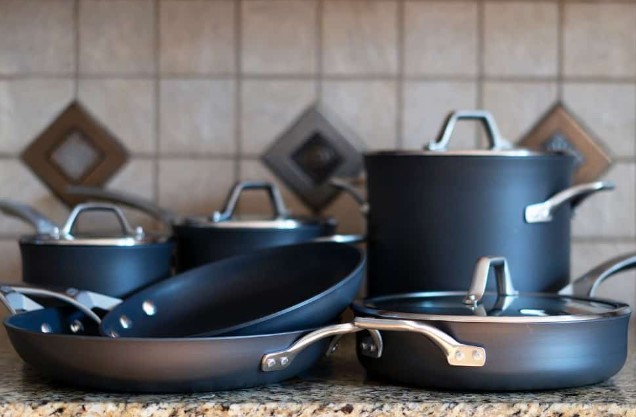
How To Clean Calphalon Pans
Cleaning Calphalon pans is crucial to maintaining their quality and extending their lifespan. Here are seven steps to effectively clean your Calphalon pans:
Step 1: Let It Cool Down
Step 1 in effectively cleaning your Calphalon pans is allowing them to cool down after use. This step is crucial to prevent any potential damage to the pan’s surface or nonstick coating.
Placing a hot pan directly under cold water can lead to thermal shock, causing the pan to warp or develop cracks over time. By letting the pan cool naturally to room temperature, you ensure that it retains its shape and structural integrity.
Moreover, cooling down the pan makes it easier to handle during the cleaning process, reducing the risk of accidental burns or injuries.
Overall, taking the time to let your Calphalon pans cool down is a simple yet essential step in maintaining their quality and longevity.
Step 2: Water It Down
Step 2 in the process of cleaning your Calphalon pans is to water them down. After allowing the pans to cool, fill your sink or a basin with warm water.
The warm water helps to loosen any stuck-on food particles and makes the cleaning process more effective. You can also add a mild dishwashing detergent to the water to create a soapy solution.
Submerge the Calphalon pans in the water and let them soak for a few minutes. This soaking period helps to further soften any residues, making them easier to remove during scrubbing.
Watering down the pans is an important step in preparing them for gentle cleaning, ensuring that you can remove dirt and grime without damaging the pan’s surface.
Step 3: Soak It
Step 3 involves soaking your Calphalon pans in warm, soapy water. After filling your sink or basin with warm water and adding a mild dishwashing detergent, submerge the pans completely.
Allowing them to soak for a few minutes is beneficial as it softens any stubborn food residues or grease, making them easier to clean. This soaking step is particularly useful for pans with stuck-on food or stubborn stains.
It also minimizes the effort required during scrubbing, reducing the risk of scratching the pan’s surface. However, avoid prolonged soaking, especially for nonstick pans, as it can degrade the nonstick coating over time.
A brief soak followed by gentle cleaning is an effective way to ensure your Calphalon pans remain clean and well-maintained.
Step 4: Scrubbing
Step 4 involves gentle scrubbing to remove any food residues or stains from your Calphalon pans. After soaking the pans in warm, soapy water, use a soft sponge or dishcloth to scrub the surface.
It’s important to use gentle pressure and avoid abrasive materials like steel wool or harsh scouring pads, as they can scratch the nonstick coating or the stainless steel surface of the pan.
Focus on areas with stubborn residues, applying a bit more pressure if needed, but always be cautious to prevent damage. For particularly tough stains or stuck-on food, you can create a paste using baking soda and water and apply it to the affected area before scrubbing.
Rinse the pan thoroughly after scrubbing to remove any soap or residue, ensuring a clean and pristine surface for your Calphalon pans.
Step 5: Rinsing Your Pans
Step 5 involves thoroughly rinsing your Calphalon pans after scrubbing to remove any remaining soap residue or food particles. Use warm water to rinse the pans, ensuring that all surfaces are thoroughly cleaned.
Pay attention to corners, edges, and any crevices where residue may hide. A good rinse helps to ensure that your pans are clean and free from any soap or cleaning agents that could affect the flavor of your next meal.
After rinsing, inspect the pans to ensure they are completely clean before proceeding to the next step.
Step 6: Drying
Step 6 is drying your Calphalon pans after rinsing. There are two primary methods for drying your pans: air drying and towel drying.
For air drying, simply place the rinsed pans on a dish rack or clean, dry surface. Allow them to air dry naturally, ensuring that they are completely dry before storing them. Air drying is convenient and prevents the risk of lint or fibers from towels sticking to the pans.
Alternatively, you can towel dry your pans using a soft, clean cloth. Gently wipe the pans to remove excess water and moisture.
Pay attention to areas where water may collect, such as handles and edges. Towel drying ensures a thorough drying process and prevents water spots or streaks on the pan’s surface.
Whichever method you choose, ensure that your Calphalon pans are completely dry before storing them. Proper drying helps prevent water stains, corrosion, and prolongs the lifespan of your pans, keeping them in top condition for future use.
Step 7: Storing
Step 7 in caring for your Calphalon pans is proper storage. Once they are thoroughly dry, store your pans in a way that protects their surfaces from scratches or damage.
If you have multiple pans, consider using pan protectors or placing a soft cloth between them to prevent scratching. Avoid stacking heavy items on top of the pans, as this can deform their shape over time.
Moreover, store your Calphalon pans in a cool, dry place away from direct heat or sunlight, as excessive heat can damage the nonstick coating.
Proper storage not only preserves the appearance of your pans but also ensures they remain in optimal condition for cooking delicious meals for years to come.
Removing Stubborn Stains or Residue
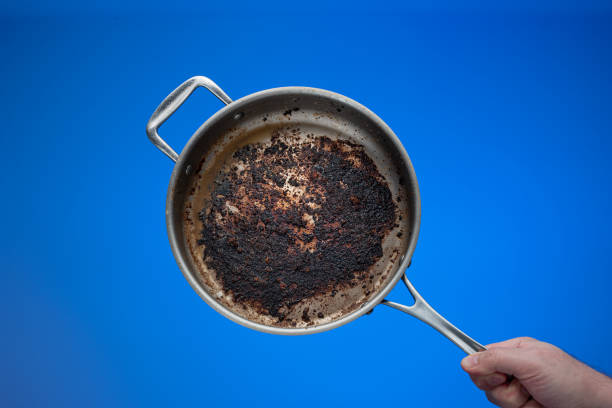
Removing stubborn stains or residue from your Calphalon pans can be done effectively with a few tips and methods that don’t harm the pan’s surface.
- Soaking: For pans with burnt-on food or tough stains, soaking them in warm, soapy water for an extended period can help loosen the residues. Adding a few drops of dishwashing detergent to the water aids in breaking down the grime.
- Baking Soda Paste: Create a paste using baking soda and water, then apply it to the stained or burnt areas. Let it sit for a while to allow the baking soda’s gentle abrasive properties to work on the stains. Afterward, scrub the area with a soft sponge or cloth.
- Vinegar Solution: Vinegar is a natural cleaner that can help dissolve tough residues. Mix equal parts of white vinegar and water in a spray bottle. Spray the solution onto the stained areas and let it sit for a few minutes. Wipe the pan with a soft cloth or sponge to remove the residue.
- Avoid Abrasive Tools: When dealing with stubborn stains, avoid using abrasive tools like steel wool or harsh scrubbing pads, as they can scratch the pan’s surface. Opt for soft sponges or non-abrasive scrubbers to protect the pan’s nonstick coating or stainless steel surface.
- Rinse Thoroughly: After cleaning the stains, rinse the pan thoroughly with warm water to remove any cleaning agents or residues. Ensure that all traces of the baking soda paste or vinegar solution are completely rinsed off.
By following these tips and using gentle cleaning methods, you can effectively remove stubborn stains or burnt-on food from your Calphalon pans without causing damage. Regular maintenance and proper cleaning techniques help preserve the pan’s quality and extend its lifespan for long-term use.
Care and Maintenance
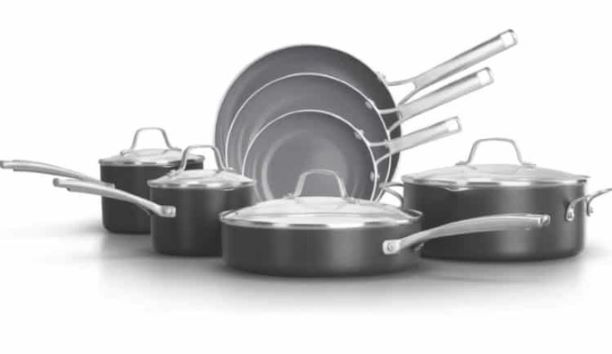
Storage Tips
Care and maintenance of your Calphalon pans extend beyond just cleaning. Here are some storage tips to keep your pans in great condition:
- Proper Storage: Store your Calphalon pans in a way that prevents scratches or dents. Avoid stacking heavy items on top of them, as this can deform the shape of the pans or cause scratches on the surfaces. If you have multiple pans, consider storing them vertically rather than stacked on top of each other.
- Use Pan Protectors: Consider using pan protectors between stacked pans. Pan protectors are soft, fabric or felt discs that provide a cushioning layer between pans, preventing scratches and preserving the nonstick coating or stainless steel finish.
- Stacking Pans with Care: If you need to stack pans, do so with care. Place a pan protector or a soft cloth between each pan to avoid direct contact and minimize the risk of scratches. Stack pans of similar sizes together to distribute weight evenly and prevent deformation.
- Avoid Hanging Pans: While hanging pans can save space, avoid doing so if it puts excessive strain on the pan’s handles or causes them to deform. If you choose to hang your pans, use sturdy hooks or racks designed for cookware and ensure that the weight is evenly distributed to avoid damage.
Regular Inspection
Regular inspection is key to maintaining the quality and longevity of your Calphalon pans. Here are some tips for conducting regular inspections:
- Check for Wear and Damage: Regularly inspect your Calphalon pans for signs of wear, such as scratches, chips, or worn nonstick coatings. Addressing these issues promptly can prevent further damage and ensure optimal cooking performance. If you notice any damage, consider consulting the manufacturer or a professional for maintenance or repair options.
- Follow Manufacturer’s Guidelines: Adhere to the manufacturer’s guidelines for long-term care and maintenance of your Calphalon pans. This includes following recommended cleaning methods, avoiding harsh cleaning agents or tools that can damage the surface, and storing the pans properly to prevent damage during storage. The manufacturer’s guidelines also often include information on warranty coverage and recommended maintenance procedures to keep your pans in top condition.
Troubleshooting Common Issues
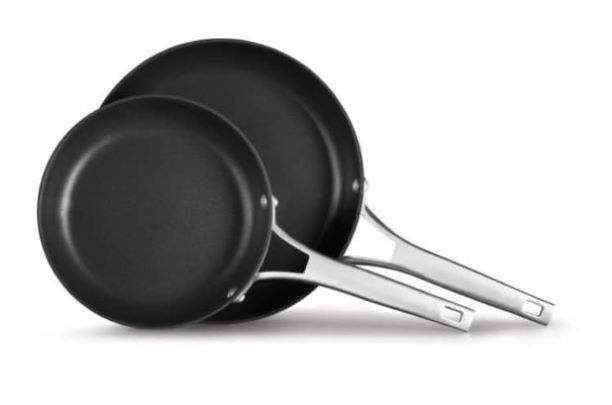
Addressing common issues with Calphalon pans ensures they maintain their performance and longevity. Here are solutions and preventive measures for common problems:
Sticking Food
- Solution: Ensure the pan is properly preheated before adding food. Use enough oil or butter to create a barrier between the food and the pan’s surface. Avoid overcrowding the pan, which can trap moisture and lead to sticking.
- Preventive Measures: Preheat the pan on medium heat for a few minutes before adding food. Use silicone or wooden utensils to avoid scratching the nonstick coating. Clean the pan thoroughly after each use to remove any residue that can cause sticking.
Discoloration
- Solution: Avoid using high heat settings, which can cause discoloration. Use mild dish soap and non-abrasive cleaning tools when washing the pan. For stubborn stains, use baking soda paste or vinegar solutions.
- Preventive Measures: Use medium to low heat settings for cooking. Avoid using metal utensils or abrasive cleaning tools that can scratch the pan’s surface. Dry the pan thoroughly after washing to prevent water spots or stains.
Loss of Non-Stick Properties
- Solution: Season the pan regularly with a thin layer of oil to maintain its nonstick properties. Avoid using cooking sprays with additives that can build up on the pan’s surface.
- Preventive Measures: Follow the manufacturer’s guidelines for seasoning and care. Use silicone or wooden utensils to avoid damaging the nonstick coating. Avoid using abrasive cleaning agents or tools that can degrade the nonstick properties.
By implementing these solutions and preventive measures, you can troubleshoot common issues with Calphalon pans and ensure they continue to perform optimally for a long time. Regular maintenance and proper use are key to preserving the quality of your cookware.
Other Calphalon Cookware Cleaning Tips
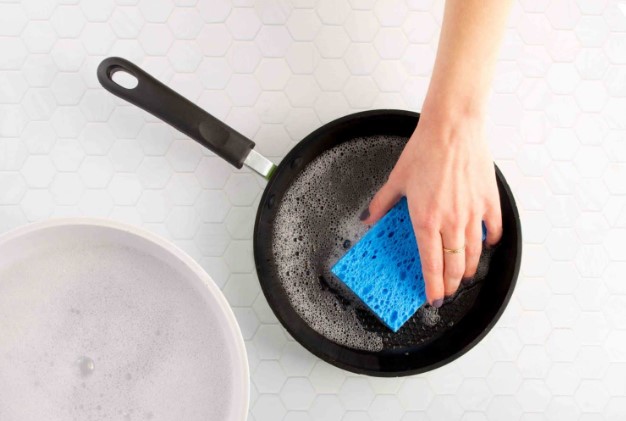
Here are some additional cleaning tips specifically tailored for different types of Calphalon cookware:
Calphalon Nonstick Cookware
- Use mild dish soap and warm water for regular cleaning. Avoid using abrasive cleaners or scrubbers that can damage the nonstick coating.
- To remove stubborn stains or residues, soak the pan in warm, soapy water or use a baking soda paste. Gentle scrubbing with a soft sponge or cloth should suffice.
- Avoid using metal utensils that can scratch the nonstick surface. Opt for silicone, wooden, or plastic utensils instead.
Calphalon Stainless Steel Cookware
- Use a non-abrasive stainless steel cleaner or a mixture of vinegar and water for regular cleaning. Avoid using bleach or harsh chemicals that can damage the stainless steel finish.
- To remove burnt-on food or stains, soak the pan in a vinegar solution or use a stainless steel cleaner with a non-abrasive scrubber.
- Dry the stainless steel cookware thoroughly after washing to prevent water spots or stains.
Calphalon Hard-Anodized Cookware
- Clean hard-anodized cookware with mild dish soap and warm water. Avoid using abrasive cleaners or scrubbers that can scratch the surface.
- For tough stains or residues, soak the pan in warm, soapy water or use a baking soda paste. Gently scrub with a soft sponge or cloth.
- Avoid using metal utensils that can scratch the hard-anodized surface. Use silicone, wooden, or plastic utensils instead.
Calphalon Ceramic Cookware
- Clean ceramic cookware with mild dish soap and warm water. Avoid using abrasive cleaners or scrubbers that can scratch the ceramic coating.
- To remove stubborn stains or residues, soak the pan in warm, soapy water or use a baking soda paste. Gently scrub with a soft sponge or cloth.
- Avoid using metal utensils that can scratch the ceramic surface. Opt for silicone, wooden, or plastic utensils instead.
Calphalon Cast Iron Cookware
- Clean cast iron cookware with warm water and a stiff brush. Avoid using soap or detergent, as it can strip the seasoning from the cast iron.
- After cleaning, dry the cast iron cookware thoroughly and apply a thin layer of oil to prevent rusting.
- Store cast iron cookware in a dry place to prevent moisture buildup.
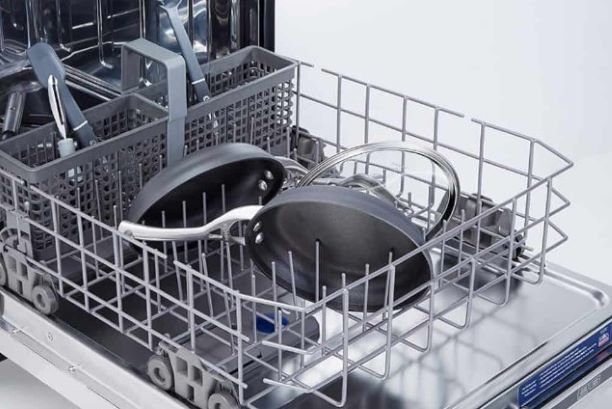
Frequently Asked Questions (FAQs) – How To Clean Calphalon Pans
Q: How do I clean my Calphalon pans without damaging them?
A: Cleaning your Calphalon pans is easy! Start by letting them cool slightly, then use a gentle sponge or cloth with warm, soapy water to wipe away any food residue. Avoid harsh abrasives or metal utensils that could scratch the surface.
Q: Can I use a dishwasher to clean my Calphalon pans?
A: Yes, most Calphalon pans are dishwasher safe, making cleanup a breeze. Just be sure to use a mild detergent and avoid overcrowding the dishwasher to ensure thorough cleaning and prevent damage.
Q: What’s the best way to remove stubborn stains from my Calphalon pans?
A: For tough stains, try soaking your pan in warm, soapy water for a few hours before gently scrubbing with a non-abrasive sponge or nylon brush. You can also use a mixture of baking soda and water for extra cleaning power.
Q: How do I keep my Calphalon pans looking like new?
A: To maintain the beauty and performance of your Calphalon pans, avoid using cooking sprays containing silicone, as they can build up and create a sticky residue. Instead, use a small amount of oil or butter for cooking, and clean your pans promptly after each use.
Q: Can I use metal utensils with my Calphalon pans?
A: While Calphalon pans are durable, it’s best to use non-metal utensils like silicone or wooden spatulas to avoid scratching the nonstick surface. This will help prolong the lifespan of your pans and keep them in top condition.
Q: How often should I clean and maintain my Calphalon pans?
A: For optimal performance, clean your Calphalon pans after each use and avoid letting food residue sit for too long. Regular maintenance, such as seasoning nonstick pans and storing them properly, will ensure they continue to perform beautifully for years to come.
Q: Are there any special tips for cleaning specific Calphalon pan types, like stainless steel or nonstick?
A: While the cleaning process is generally similar for all Calphalon pans, it’s important to follow the manufacturer’s instructions for each type. For stainless steel pans, a stainless steel cleaner can help restore shine, while nonstick pans benefit from gentle cleaning to preserve the coating.
Q: What’s the best way to clean burnt-on residue from my Calphalon pans?
A: If you have stubborn burnt-on food, try soaking the pan in a mixture of warm water and vinegar or lemon juice overnight. This will help loosen the residue, making it easier to clean with a gentle sponge or scrubber the next day.
Q: Can I use abrasive cleaners like steel wool on my Calphalon pans?
A: It’s best to avoid abrasive cleaners or steel wool pads on Calphalon pans, as they can scratch the surface and diminish the nonstick properties. Stick to gentle cleaning tools and methods to protect the quality of your pans.
Q: How do I prevent my Calphalon pans from warping during cleaning?
A: To avoid warping, always let your pans cool down before cleaning them with water. Rapid temperature changes can cause thermal shock and lead to warping. Moreover, avoid placing hot pans directly under cold water or in a cold sink.
Conclusion
Cleaning Calphalon pans effectively ensures their longevity and performance in the kitchen.
By following the right techniques, such as gentle scrubbing with non-abrasive materials, using mild dish soap, and avoiding harsh chemicals or metal utensils, you can maintain the non-stick coating and the overall quality of your Calphalon pans.
Regular cleaning after each use, along with occasional deep cleaning as needed, keeps your pans looking new and ready for cooking adventures.
Remember, proper care not only preserves the beauty of your cookware but also enhances its functionality, allowing you to enjoy delicious meals with ease for years to come.
Other Articles You May Also Like:
- How To Clean Burnt Pan (23 Cool Ways)
- How To Clean Roasting Pan (10 Effective Ways)
- How To Clean Stove Drip Pans (8 Easy Ways)
- How To Clean Baking Sheets (6 Easy Ways)
- How To Clean Muffin Pan (4 Easy Steps)
- How To Clean Stainless Steel Pans (13 Cool Ways)
- How To Clean A Non Stick Pan (5 Revealing Steps)